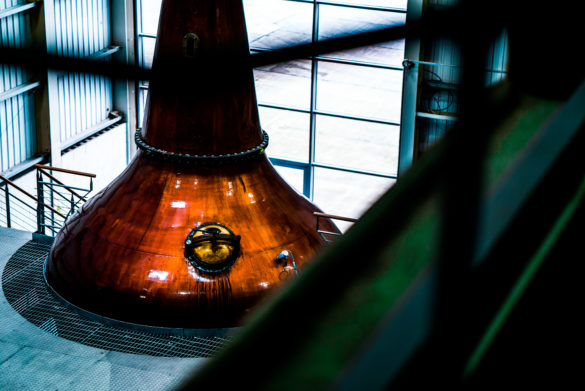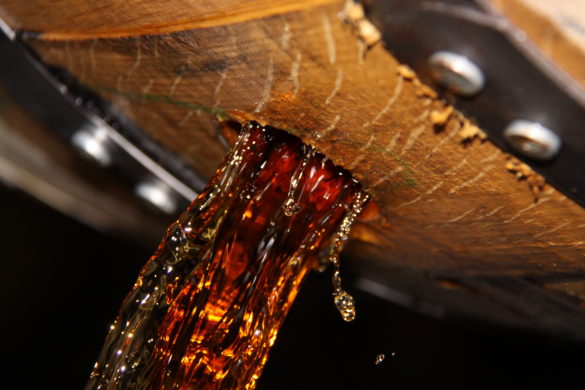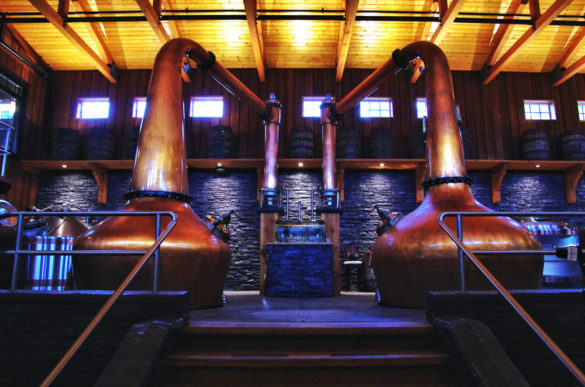Continuing our series of posts looking at whisky making, terminology and style, it’s time to go global. Whisky is made around the world, but it’s a bit different wherever you find a distillery. In this post, we break down some of the ways that whisky is talked about around the world, and find out how it differs
Scotch Whisky

Old-school whisky sampling at Aberlour distillery
Lots of countries around the world use the same terminology as the Scottish whisky makers, so it’s useful to understand their traditions and types of whisky.
Malt Whisky – this is whisky made using 100% malted barley (aka malt). There are other rules as well (all listed in the Scotch Whisky Regulations 2009, if you like looking at legal texts), but the most important other detail is that malt whisky must be made using copper pot stills – the old fashioned copper kettles you find in traditional distilleries around the world. In general, they are rich and complex spirits.
Grain Whisky – the ‘other’ type of whisky made in Scotland. This is made using grains other than malted barley (mostly a mix of a little bit of malt and something else) and/or using a still that isn’t a traditional copper pot still. In general, they are lighter and more delicate spirits.
Single Malt Whisky – malt whisky (the malt part at the name) made at one distillery and not mixed with whisky from other distilleries (the single part). This is the whisky most commonly thought of as ‘best’, although there are great whiskies of all styles available.
Blended Malt Whisky – a mixture of malt whiskies made at different distilleries. These are much less common than single malts, and bring together flavours from different producers to create something that you couldn’t get from one distillery alone.
Blended Whisky – a mixture of grain whisky and malt whisky. This is the most popular style of Scotch whisky, with brands like Johnnie Walker and Chivas Regal the biggest in the world. They range from very affordable up to very expensive, and cover styles from rich and deeply-flavoured to light and delicate.
Peat – peat is a fuel used around the world: burn it and it provides heat. It’s composed of decomposed vegetation that has been compressed over years into a rich earthy material – like a muddy, softer coal – which burns very well when dried. When used to dry barley that’s used to make whisky, it adds a smoky flavour that lasts all the way from the beginning of the whisky making process into the final spirit. It’s not as common a flavour as people often think, but it is very popular among Scotch whisky fans.
Independent Bottler – not all whisky is bottled by the people who make it. Behind the scenes, casks of whisky are traded not only between companies making blended whisky (who need the varied flavours that different distilleries provide) but also independent bottling companies, who select casks and bottle them under their own label. Companies like Signatory Vintage, Gordon & MacPhail, Douglas and Hunter Laing, and Elixir Distillers are well known for choosing great casks, which often show a different side to a distillery’s character than their own bottlings.
Find out more – 20 independent whisky bottlers you need to know >
Irish Whiskey

The pot stills at Waterford, one of Ireland’s new wave of distilleries
The styles and traditions of Irish whiskey are quite similar to those in Scotland. However:
Pot Still Whiskey – this traditional style is now being made in other countries, but originated in Ireland. Rather than just using malted barley, it also uses a proportion of unmalted barley in the mix, as well as other grains, all run through a traditional pot still. While this would be called grain whisky in Scotland, in Ireland it’s a separate category and creates a richer and more complex spirit than you usually find in Scottish grain.
Bonders – the tradition of independent bottling has a long history in Ireland, but due to there only being a handful of Irish distilleries until recently, it’s not been common for decades. With the resurgence in Irish distilling (there are now tens of distilleries starting up across the country, up from just three in the 1980s) bonders, as indie bottlers are known across the Irish sea, are again becoming an important part of the Irish whiskey scene.
Find out more – What is Irish whiskey? >
American Whiskey

Liquid gold at Buffalo Trace
The USA’s whiskey scene is very different to that around the world, with a very different set of production techniques and categories (although, single malt is starting to pick up a following). Lots of these rarely leave the USA (blended whiskey, which means something very different in America, and spirit whiskey being two examples), but the ones that do are quite well known:
Bourbon whiskey – a whiskey made using a recipe that includes at least 50% maize (aka corn). The rest of the recipe is usually made with a bit of malted barley and then other grains including rye and wheat among others. It has to be aged in new oak casks, something that gives American whiskey its punchy, sweet and woody character. The corn also adds a chunk of perceived sweetness to the final spirit, which doesn’t actually contain any sugar.
Rye/Wheat/Oat/etc whiskey – a whiskey made using a recipe that is made up of at least 50% rye/wheat/oats/etc. Basically the same as bourbon, but with a different dominant grain. Rye adds spiciness, wheat is soft, oats are creamy…
Corn whiskey – just to ensure that American whiskey categories aren’t simple, Corn whiskey has to be made with at least 80% maize and is either unaged or aged in used casks.
Tennessee Whiskey – while Jack Daniel’s is the most famous Tennessee whiskey, there are other distilleries now popping up over the state. To call itself Tennessee whiskey, a spirit must meet all of the rules for bourbon, be made in Tennessee and be filtered through charcoal before being filled into cask…just like Jack Daniel’s is.
Straight whiskey – a slightly confusing term which means that a whiskey has been aged for at least two years in oak. However, if it has been aged for less than four years, it has to say how long on the label.
Bottled in Bond – a legal term with a few different pieces to it, but in general it means that the whiskey is bottled at 50% and has been supervised more stringently during its maturation.
Find out more – Bourbon vs Scotch: what’s the difference? >
World Whisky

Shelter Point – making single malt on Vancouver Island in Canada since 2011
While Scotland, Ireland and America (along with Canada and Japan, depending on how you judge things) are the big distilling nations, you can now find whisky pretty much everywhere around the world. Keep an eye out for whisky from Taiwan, Sweden, Mexico, South Africa, Australia and even…England.
It’s mostly made in a similar way to whisky from Scotland and Ireland (other than Canada, which mixes that with a touch of US technique and ingredients), but there are loads of local variations, styles, ingredients and traditions which make a whole host of different flavours.
Where to find out more
The Whisky Exchange is dedicated to not only finding you great drinks, but also helping you find out more about those great drinks. There’s a whole host of information here on the site, as well as educational Focus On pages and regular new features over on our website.
We also have a selection of whisky books, including our own – Everything you Need to Know about Whisky (but are too afraid to ask) – and even mine: The Philosophy of Whisky.
And, if all else fails, don’t hesitate to drop us a line – our customer service team and in-house experts are always happy to offer advice on what your next bottle should be.






 Enjoy responsibly
Enjoy responsibly
Recent Comments
Unfortunately, the answer is 'between 400g and 2000g per litre' :)
Posted on: 9 October 2024
What ratio of Sloe to gin is used, I see anything from 400 to 2000g of sloe to 1 litre of gin!
Posted on: 7 October 2024
What really makes Bob Harris' predicament in 'Lost In Translation' so absurdly funny is that he nailed it in one take, and the director just couldn't accept that.
Posted on: 11 January 2024